计算机组成原理计算题设计题
计算机组成原理试题6

计算机组成原理试题6一、选择题(共5分,每题1分)1.某机字长8位,采用补码形式(其中1位为符号位),则机器数所能表示的范围是______。
A.-127 ~127;B.-128 ~+128;C.-128 ~+127;D.-128 ~+128。
2.在______的计算机系统中,外设可以和主存储器单元统一编址,因此可以不使用I/O 指令。
A.单总线;B.双总线;C.三总线;D.以上三种总线。
3.某计算机字长是32位,它的存储容量是64KB.按字编址,它的寻址范围是______。
A.16KB;B.16K;C.32K;D.32KB。
4.中断向量可提供______。
A.被选中设备的地址;B.传送数据的起始地址;C.中断服务程序入口地址;D.主程序的断点地址。
5.Cache的地址映象中比较多的采用“按内容寻址”的相联存储器来实现。
A.直接映象;B.全相联映象;C.组相联映象;D.以上都有。
6.总线的异步通信方式______。
A.不采用时钟信号,只采用握手信号;B.既采用时钟信号,又采用握手信号;C.既不采用时钟信号,又不采用握手信号;D.采用时钟信号,不采用握手信号。
7.在磁盘存储器中,查找时间是______。
A.使磁头移动到要找的柱面上所需的时间;B.在磁道上找到要找的扇区所需的时间;C.在扇区中找到要找的数据所需的时间。
D.以上都不对。
8.在控制器的控制信号中,相容的信号是______的信号。
A.可以相互替代;B.可以相继出现;C.可以同时出现;D.不可以同时出现。
9.计算机操作的最小单位时间是______。
A.时钟周期;B.指令周期;C.CPU周期;D.执行周期。
10.CPU不包括______。
A.地址寄存器;B.指令寄存器IR;C.地址译码器;D.通用寄存器。
11.寻址便于处理数组问题。
A.间接寻址;B.变址寻址;C.相对寻址;D.立即寻址。
12.设寄存器内容为10000000,若它等于0,则为______。
计算机组成原理计算题
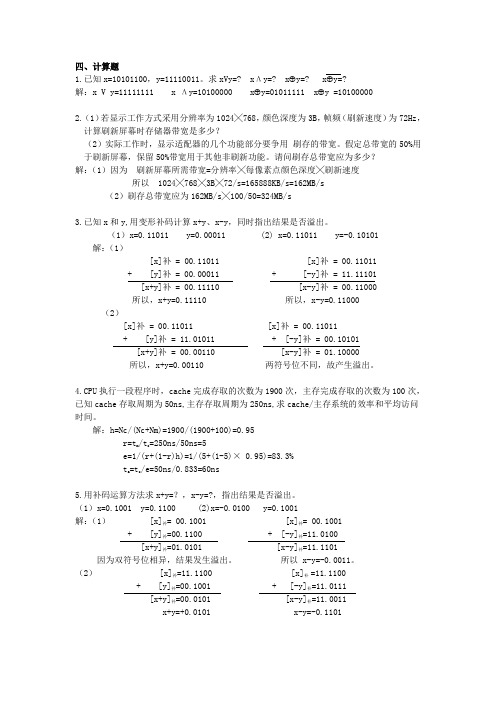
四、计算题1.已知x=10101100,y=11110011。
求xVy=? xΛy=? x⊕y=? x⊕y=?解:x V y=11111111 x Λy=10100000 x⊕y=01011111 x⊕y =101000002.(1)若显示工作方式采用分辨率为1024╳768,颜色深度为3B,帧频(刷新速度)为72Hz,计算刷新屏幕时存储器带宽是多少?(2)实际工作时,显示适配器的几个功能部分要争用刷存的带宽。
假定总带宽的50%用于刷新屏幕,保留50%带宽用于其他非刷新功能。
请问刷存总带宽应为多少?解:(1)因为刷新屏幕所需带宽=分辨率╳每像素点颜色深度╳刷新速度所以 1024╳768╳3B╳72/s=165888KB/s=162MB/s(2)刷存总带宽应为162MB/s╳100/50=324MB/s3.已知x和y,用变形补码计算x+y、x-y,同时指出结果是否溢出。
(1)x=0.11011 y=0.00011 (2) x=0.11011 y=-0.10101 解:(1)[x]补 = 00.11011 [x]补 = 00.11011+ [y]补 = 00.00011 + [-y]补 = 11.11101[x+y]补 = 00.11110 [x-y]补 = 00.11000所以,x+y=0.11110 所以,x-y=0.11000 (2)[x]补 = 00.11011 [x]补 = 00.11011+ [y]补 = 11.01011 + [-y]补 = 00.10101[x+y]补 = 00.00110 [x-y]补 = 01.10000所以,x+y=0.00110 两符号位不同,故产生溢出。
4.CPU执行一段程序时,cache完成存取的次数为1900次,主存完成存取的次数为100次,已知cache存取周期为50ns,主存存取周期为250ns,求cache/主存系统的效率和平均访问时间。
解:h=Nc/(Nc+Nm)=1900/(1900+100)=0.95r=tm /tc=250ns/50ns=5e=1/(r+(1-r)h)=1/(5+(1-5)× 0.95)=83.3%ta =tc/e=50ns/0.833=60ns5.用补码运算方法求x+y=?,x-y=?,指出结果是否溢出。
计算机组成原理例题
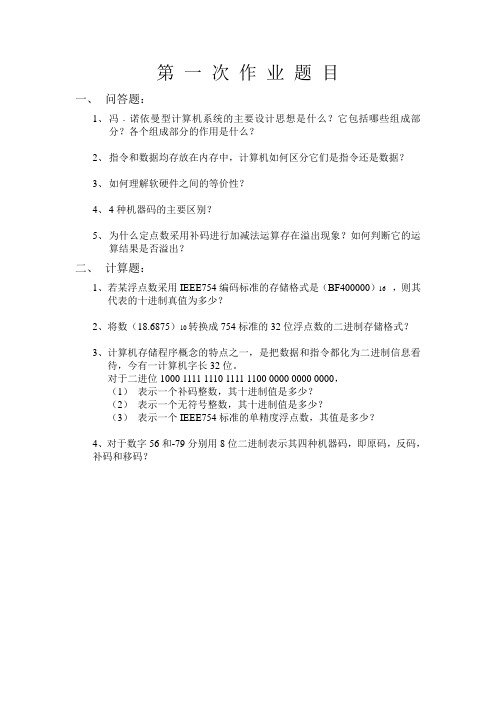
第一次作业题目
一、问答题:
1、冯﹒诺依曼型计算机系统的主要设计思想是什么?它包括哪些组成部
分?各个组成部分的作用是什么?
2、指令和数据均存放在内存中,计算机如何区分它们是指令还是数据?
3、如何理解软硬件之间的等价性?
4、4种机器码的主要区别?
5、为什么定点数采用补码进行加减法运算存在溢出现象?如何判断它的运
算结果是否溢出?
二、计算题:
1、若某浮点数采用IEEE754编码标准的存储格式是(BF400000)16 ,则其
代表的十进制真值为多少?
2、将数(18.6875)10转换成754标准的32位浮点数的二进制存储格式?
3、计算机存储程序概念的特点之一,是把数据和指令都化为二进制信息看
待,今有一计算机字长32位。
对于二进位1000 1111 1110 1111 1100 0000 0000 0000,
(1)表示一个补码整数,其十进制值是多少?
(2)表示一个无符号整数,其十进制值是多少?
(3)表示一个IEEE754标准的单精度浮点数,其值是多少?
4、对于数字56和-79分别用8位二进制表示其四种机器码,即原码,反码,
补码和移码?。
计算机组成原理(附答案)
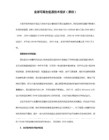
计算机组成原理计算题
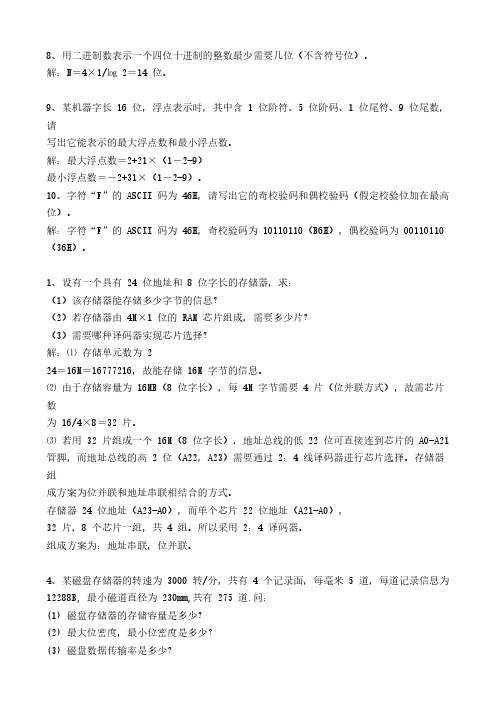
8、用二进制数表示一个四位十进制的整数最少需要几位(不含符号位)。
解:N=4×1/㏒ 2=14 位。
9、某机器字长 16 位,浮点表示时,其中含 1 位阶符、5 位阶码、1 位尾符、9 位尾数,请写出它能表示的最大浮点数和最小浮点数。
解:最大浮点数=2+21×(1-2-9)最小浮点数=-2+31×(1-2-9)。
10、字符“F”的 ASCII 码为 46H,请写出它的奇校验码和偶校验码(假定校验位加在最高位)。
解:字符“F”的 ASCII 码为 46H,奇校验码为 10110110(B6H),偶校验码为 00110110(36H)。
1、设有一个具有 24 位地址和 8 位字长的存储器,求:(1)该存储器能存储多少字节的信息?(2)若存储器由 4M×1 位的 RAM 芯片组成,需要多少片?(3)需要哪种译码器实现芯片选择?解:⑴ 存储单元数为 224=16M=16777216,故能存储 16M 字节的信息。
⑵ 由于存储容量为 16MB(8 位字长),每 4M 字节需要 4 片(位并联方式),故需芯片数为 16/4×8=32 片。
⑶ 若用 32 片组成一个 16M(8 位字长),地址总线的低 22 位可直接连到芯片的 A0-A21管脚,而地址总线的高 2 位(A22,A23)需要通过 2:4 线译码器进行芯片选择。
存储器组成方案为位并联和地址串联相结合的方式。
存储器 24 位地址(A23-A0),而单个芯片 22 位地址(A21-A0),32 片,8 个芯片一组,共 4 组。
所以采用 2:4 译码器。
组成方案为:地址串联,位并联。
4、某磁盘存储器的转速为 3000 转/分,共有 4 个记录面,每毫米 5 道,每道记录信息为 12288B, 最小磁道直径为 230mm,共有 275 道.问:(1) 磁盘存储器的存储容量是多少?(2) 最大位密度,最小位密度是多少?(3) 磁盘数据传输率是多少?(4) 平均等待时间是多少?解:⑴ 磁盘存储器的存储容量=4×275×12288=13516800 字节⑵ 因为最小半径 R1=230/2=115,最小磁道长度为 2πR1=2×3.14159×115=722.57mm所以最高位密度=12288/722.57=17 字节又因为最大半径 R2=R1+275/5=115+55=170最大磁道长度为 2πR2=2×3.14159×170=1068所以最低位密度=12288/1068=11.5 字节⑶ 磁盘数据传输率 c=r×Nr=3000/60=50 转/秒;N=12288 字节/道所以 c=50×12288=614400 字节。
(完整版)计算机组成原理练习(3)答案
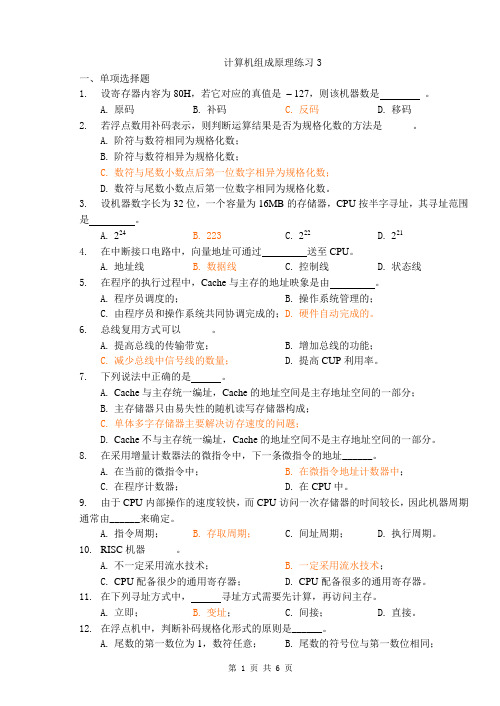
计算机组成原理练习3一、单项选择题1. 设寄存器内容为80H,若它对应的真值是– 127,则该机器数是。
A. 原码B. 补码C. 反码D. 移码2. 若浮点数用补码表示,则判断运算结果是否为规格化数的方法是______。
A. 阶符与数符相同为规格化数;B. 阶符与数符相异为规格化数;C. 数符与尾数小数点后第一位数字相异为规格化数;D. 数符与尾数小数点后第一位数字相同为规格化数。
3. 设机器数字长为32位,一个容量为16MB的存储器,CPU按半字寻址,其寻址范围是。
A. 224B. 223C. 222D. 2214. 在中断接口电路中,向量地址可通过送至CPU。
A. 地址线B. 数据线C. 控制线D. 状态线5. 在程序的执行过程中,Cache与主存的地址映象是由。
A. 程序员调度的;B. 操作系统管理的;C. 由程序员和操作系统共同协调完成的;D. 硬件自动完成的。
6. 总线复用方式可以______。
A. 提高总线的传输带宽;B. 增加总线的功能;C. 减少总线中信号线的数量;D. 提高CUP利用率。
7. 下列说法中正确的是。
A. Cache与主存统一编址,Cache的地址空间是主存地址空间的一部分;B. 主存储器只由易失性的随机读写存储器构成;C. 单体多字存储器主要解决访存速度的问题;D. Cache不与主存统一编址,Cache的地址空间不是主存地址空间的一部分。
8. 在采用增量计数器法的微指令中,下一条微指令的地址______。
A. 在当前的微指令中;B. 在微指令地址计数器中;C. 在程序计数器;D. 在CPU中。
9. 由于CPU内部操作的速度较快,而CPU访问一次存储器的时间较长,因此机器周期通常由______来确定。
A. 指令周期;B. 存取周期;C. 间址周期;D. 执行周期。
10. RISC机器______。
A. 不一定采用流水技术;B. 一定采用流水技术;C. CPU配备很少的通用寄存器;D. CPU配备很多的通用寄存器。
计算机组成原理计算题

计算机组成原理计算题为什么外围设备要通过接⼝与CPU相连?接⼝有哪些功能?(6分)答:外围设备要通过接⼝与CPU相连的原因主要有:(1)⼀台机器通常配有多台外设,它们各⾃有其设备号(地址),通过接⼝可实现对设备的选择。
(2)I/O设备种类繁多,速度不⼀,与CPU速度相差可能很⼤,通过接⼝可实现数据缓冲,达到速度匹配。
(3)I/O设备可能串⾏传送数据,⽽CPU⼀般并⾏传送,通过接⼝可实现数据串并格式转换。
(4)I/O设备的⼊/出电平可能与CPU的⼊/出电平不同,通过接⼝可实现电平转换。
(5)CPU启动I/O设备⼯作,要向外设发各种控制信号,通过接⼝可传送控制命令。
(6)I/O设备需将其⼯作状况(“忙”、“就绪”、“错误”、“中断请求”等)及时报告CPU,通过接⼝可监视设备的⼯作状态,并保存状态信息,供CPU查询。
可见归纳起来,接⼝应具有选址的功能、传送命令的功能、反映设备状态的功能以及传送数据的功能(包括缓冲、数据格式及电平的转换)。
六、问答题(共15分)1.设CPU中各部件及其相互连接关系如下图所⽰。
图中W是写控制标志,R是读控制标志,R1和R2是暂存器。
(8分)(1)假设要求在取指周期由ALU完成(PC)+1→PC的操作(即ALU可以对它的⼀个源操作数完成加1的运算)。
要求以最少的节拍写出取指周期全部微操作命令及节拍安排。
答:由于(PC)+1→PC需由ALU完成,因此PC的值可作为ALU的⼀个源操作数,靠控制ALU做+1运算得到(PC)+1,结果送⾄与ALU输出端相连的R2,然后再送⾄PC。
此题的关键是要考虑总线冲突的问题,故取指周期的微操作命令及节拍安排如下:T0PC→MAR,1→RT1M(MAR)→MDR,(PC)+1→R2T2MDR→IR,OP(IR)→微操作命令形成部件T3R2→PC(2)写出指令ADD # α(#为⽴即寻址特征,隐含的操作数在ACC中)在执⾏阶段所需的微操作命令及节拍安排。
计算机组成原理参考试题

一、选择题(20分)1.二进制数左移一位,则数值()。
A.增大一倍B.减小一倍C.增大10倍D.不变2.浮点加法运算时尾数求和的结果为10.01000010,那么经规格化后的尾数为()。
A.11.00100001B.00.10000100C.11.00001000 D.00.100100003.十六进制数CC所对应的八进制数为(11001100)。
A.314B.630 C.1414 D.30304.8位二进制补码定点整数能表示的数值范围是()。
A.-128~127B.-127~127C.0~127 D.0~2555.操作数00000101与00000101执行逻辑()操作后,运算结果为00000000。
A.或B.与C.异或D.与非6.原码乘法是()。
A.用原码表示操作数,然后直接相乘B.被乘数用原码表示,乘数取绝对值,然后相乘C.乘数用原码表示,被乘数取绝对值,然后相乘D.先取操作数绝对值相乘,符号位单独处理7.在浮点数加减运算中()A.阶码部分与尾数部分分别进行加减运算B.阶码与尾数作为一个整体进行加减运算C.阶码对齐后,尾数相加减运算D.尾数单独加减,去两数中最大阶码值作为结果的阶码值8.已知某字符的编码为0100101,若最高位增加一个偶校验位,则其编码变为()。
A.10100101B.11001010 C.01000110 D.010101019.计算机各功能部件之间的合作关系如下图所示。
假设图中虚线表示控制流,实线表示数据流,那么a、b和c分别表示()。
A.控制器、内存储器和运算器B.控制器、运算器和内存储器C.内存储器、运算器和控制器D.内存储器、控制器和运算器10.CPU从内存中读取指令时,需要先将程序计数器(PC)的内容输送到()总线上。
A.数据B.地址C.控制D.接口11.若存储器按字节编址且指令长度为16位,则程序顺序执行时,每执行一条指令,程序计数器的值增加()。
A.1 B.2C.3 D.412.计算机加电自检以后,引导程序首先装入(),否则,计算机不能做任何事情。
计算机组成原理试题及答案
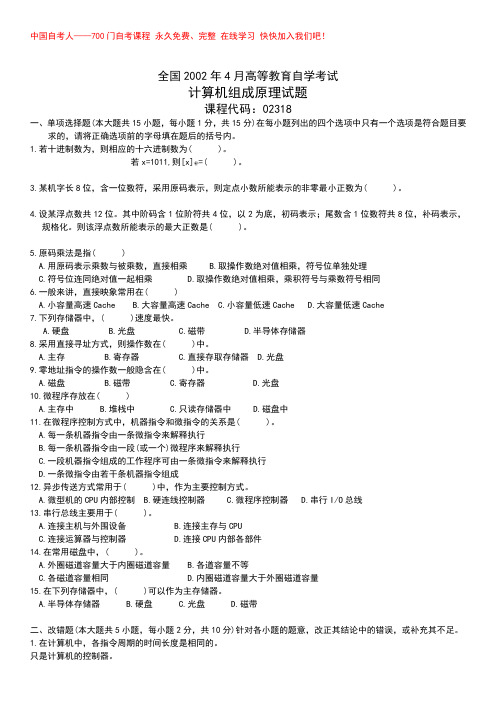
中国自考人——700门自考课程永久免费、完整在线学习快快加入我们吧!全国2002年4月高等教育自学考试计算机组成原理试题课程代码:02318一、单项选择题(本大题共15小题,每小题1分,共15分)在每小题列出的四个选项中只有一个选项是符合题目要求的,请将正确选项前的字母填在题后的括号内。
1.若十进制数为,则相应的十六进制数为( )。
若x=1011,则[x]补=( )。
3.某机字长8位,含一位数符,采用原码表示,则定点小数所能表示的非零最小正数为( )。
4.设某浮点数共12位。
其中阶码含1位阶符共4位,以2为底,初码表示;尾数含1位数符共8位,补码表示,规格化。
则该浮点数所能表示的最大正数是( )。
5.原码乘法是指( )A.用原码表示乘数与被乘数,直接相乘B.取操作数绝对值相乘,符号位单独处理C.符号位连同绝对值一起相乘D.取操作数绝对值相乘,乘积符号与乘数符号相同6.一般来讲,直接映象常用在( )A.小容量高速CacheB.大容量高速CacheC.小容量低速CacheD.大容量低速Cache7.下列存储器中,( )速度最快。
A.硬盘B.光盘C.磁带D.半导体存储器8.采用直接寻址方式,则操作数在( )中。
A.主存B.寄存器C.直接存取存储器D.光盘9.零地址指令的操作数一般隐含在( )中。
A.磁盘B.磁带C.寄存器D.光盘10.微程序存放在( )A.主存中B.堆栈中C.只读存储器中D.磁盘中11.在微程序控制方式中,机器指令和微指令的关系是( )。
A.每一条机器指令由一条微指令来解释执行B.每一条机器指令由一段(或一个)微程序来解释执行C.一段机器指令组成的工作程序可由一条微指令来解释执行D.一条微指令由若干条机器指令组成12.异步传送方式常用于( )中,作为主要控制方式。
A.微型机的CPU内部控制B.硬连线控制器C.微程序控制器D.串行I/O总线13.串行总线主要用于( )。
A.连接主机与外围设备B.连接主存与CPUC.连接运算器与控制器D.连接CPU内部各部件14.在常用磁盘中,( )。
计算机组成原理(期末考卷三套附带答案)

计算机组成原理题型一、填空题(本大题共5小题,每题2分,共10分)1.若[x]原=xxxxxx ,则[x]补=( ) 2. 3. 4. 5.二、单项选择题(本大题共5小题,每题2分,共10分)从下列各题四个备选答案中选出一个正确答案,并将其代号写在题前面的括号内。
( )1.能够被计算机硬件直接识别的语言是A. 汇编语言B. 高级语言C. 机器语言D. 应用语言( )2. ( )3. ( )4. ( )5.三、计算题(本大题共2小题,每小题5分,共10分)1.用变形补码2 .四、简答题(本大题共2小题,每小题5分,共10分)1.说明2. 顺序存储器和交叉存储器√五、设计题(本大题共2小题,第一小题10分,第二小题20分,本大题30分)1.试用xxxxx 芯片,构成xxxxx 存储器.2.假设某计算机的数据通道如下图所示,请设计以下指令的微操作序列: 1) ADD Rxx ,Rxx 寄存器的内容相加后存入Rxx 。
2)六、分析题(本大题共2小题,第一小题10分,第二小题20分,本大题30分)1.现有xxxxxxx 个中断源,其优先级由高向低按xxxxxxx 顺序排列。
若中断服务程序的执行时间为xxxx μs ,根据下图所示时间轴给出的中断源请求中断的时刻。
画出CPU 执行程序的轨迹。
地址线存储总线C P U 内部总线D服务C服务B服务A服务0 10 20 30 40 50 60 70 80 90 100 120 130 140 t(μs)B与C请求D请求B请求A请求2.设磁盘组有xx片磁盘,每片有两个记录面,最上最下两个面不用。
存储区域内径xxxx,外径xxx,道密度为xxxx道/cm,内层位密度xxx0位/cm,转速转/分。
问:1)共有多少柱面?2)盘组总存储容量是多少?3)数据传输率多少?4)采用定长数据块记录格式,直接寻址的最小单位是什么?寻址命令中如何表示磁盘地址?本科生期末试卷一一.选择题(每小题1分,共10分)1.计算机系统中的存贮器系统是指______。
计算机组成原理习题及答案

概论一、选择题:1.1946年研制成功的第一台电子数字计算机称为_B_。
A.EDVAC B.ENIAC C.EVNAC D.EINAC 2.完整的计算机系统应包括__D_____.A..运算器、存储器、控制器 B.外部设备和主机 C.主机和存储器 D.配套的硬件和软件设备3.计算机系统中的存储器系统是指__D____.A.RAM存储器 B.ROM存储器 C.内存储器 D.内存储器和外存储器4.至今为止,计算机中的所有信息仍以二进制方式表示的理由是_C_____.A..节约元件B.运算速度快C.物理器件性能所致D.信息处理方便5.计算机硬件能直接执行的只有_B___.A.符号语言B.机器语言C.机器语言和汇编语言D.汇编语言二、填空题:1.计算机的硬件包括__运算器_._控制器_._存储器_._输入设备_._输出设备__.2.在计算机术语中,将运算器和控制器合在一起称为_CPU__,而将_CPU__和存储器合在一起称为__主机__.3.计算机的软件一般分为两大类:一类叫_系统__软件,一类叫_应用__软件,其中,数据库管理系统属于_系统_软件,计算机辅助教学软件属于__应用___软件.4.计算机系统中的存储器分为_内存储器_和_外存储器_.在CPU执行程序时,必须将指令存放在_内存储器__中.5.输入、输出设备以及辅助存储器统称为_外部设备___.6.计算机存储器的最小单位为__位___,1KB容量的存储器能够存储_1024*8__个这样的单位.7.在计算机系统中,多个系统部件之间信息传送的公共通路称为__总线___,就其所传送的信息的性质而言,在公共通路上传送的信息包括_数据__、__地址__和__控制___信息.三、衡量计算机性能的基本指标有哪些?答:1.基本字长 2.数据通路宽度 3.运算速度:包括CPU时钟频率和数据传输率 4.存储器的容量:包括主存储器的容量和外存储器的容量 5.外围设备及其性能 6.系统软件配置运算方法和运算器一、选择题:1.在机器数中,__B____的零的表示形式是唯一的.A.原码B.补码C.反码D.原码和反码3.若某数X的真值为-0.1010,在计算机中该数表示为1.0110,则该数所用的编码方法__B__码.A.原B.补C.反D.移4.运算器虽有许多部件组成,但核心部分是__B____.A.数据总路线B.算术逻辑运算单元C.多路开关D.通用寄存器5.在定点二进制运算器中,减法运算一般通过__D_____来实现. A.原码运算的二进制减法器 B.补码运算的二进制减法器 C.补码运算的十进制加法器 D.补码运算的二进制加法器6.在定点运算器中,无论采用双符号位还是单符号位,必须有__C___,它一般用_____来实现.A.译码电路,与非门B.编码电路,或非门C.溢出判断电路,异或门D.移位电路,与或非门7.在定点运算中产生溢出的原因是__C_____.A.运算过程中最高位产生了进位或借位B.参加运算的操作数超出了机器的表示范围C.运算的结果的操作数超出机器的表示范围D.寄存器的位数太少,不得不舍弃最低有效位二、计算题:1.把十进制数X=(+128.75)×2-10写成浮点表示的机器数,阶码、尾数分别用原码、反码和补码表示,设阶码4位,阶符1位,尾数15位,尾数符号1位. (原码:1 0010 0 100000001100000 反码:1 1101 0 100000001100000 补码:1 1110 1 100000001100000)2.已知X=-0.01111,Y=+0.11001,求[X]补, [Y]补, [-Y]补, X+Y=?,X-Y=?存储系统一、选择题:1.存储器是计算机系统中的记忆设备,它主要用来__C_____.A.存放数据B.存放程序C.存放数据和程序D.存放微程序2.存储单元是指___B_____. A.存放一个二进制信息的存储元 B.存放一个机器字的所有存储元集合 C.存放一个字节的所有存储元集合 D.存放两个字节的所有存储元集合3.存储周期是指__D___. A.存储器的读出时间 B.存储器的写入时间 C.存储器进行连续读和写操作所允许的最短时间 D.存储器进行连续写操作所允许的最短时间间隔4.和外存储器相比,内存储器的特点是_C_____.A.容量大,速度快,成本低B.容量大,速度慢,成本高C.容量小,速度快,成本高D.容量小,速度快,成本低5.某计算机字长16位,其存储容量64KB,若按字编址,那么它的寻址范围是_B_____.A.0—64KB. 0---32KC. 0---64KBD. 0---32KB6.某SRAM芯片,其存储容量为64K×16位,该芯片的地址线和数据线数目为__D__.A. 64,16B. 16,64C. 64,8D.16,167.某DRAM芯片,其存储容量为512K×8位,该芯片的地址线和数据线数目为__D___.A. 8,512B. 512,8C. 18,8D. 19,88.某机字长32位,存储容量1MB,若按字编址,它的寻址范围是__C___.A, 0—1M B. 0---512K C. 0---256K D. 0---256KB9.某计算机字长32位,其存储容量为4MB,若按字编址,它的寻址范围是__A___.A. 0---1MB. 0---4MBC. 0---4MD. 0---1MB10.某计算机字长32位,其存储容量为4MB,若按半字编址,它的寻址范围是_C____.A. 0---4MBB. 0---2MBC. 0---2MD. 0---1MB11.某计算机字长为32位,其存储容量为16MB,若按双字编址,它的寻址范围是_C____.A. 0---4MBB. 0---2MBC. 0---2MD. 0---1MB12.主存储器和CPU之间增加cache的目的是__A___.A.解决CPU和主存之间的速度匹配问题B.扩大主存储器的数量C.扩大CPU中通用寄存器的数量D.既扩大主存容量又扩大CPU通用寄存器数量13.在cache的地址映射中,若主存中的任意一块可映射到cache内的任意一块的位置上,则这种方法称为__A____.A.全相联映射B.直接映射C.组相联映射D. 混合映射二、填空题:1.对存储器的要求是_容量大__,__速度快__,__成本低___,为了解决这三方面的矛盾,计算机采用_多级__体系结构.2.CPU能直接访问_主存__和__cache__,但不能直接访问__辅存__和__外设_____.3.广泛使用的__SRAM__和__DRAM__都是半导体__随机读写__存储器.前者的速度比后者快,__集成度_不如后者高.它们的共同特点是断电后__不能___保存信息.4. cache是一种__高速缓冲__存储器,是为了解决CPU和主存之间__速度___不匹配而采用的一项重要的硬件技术.5.三级存储系统是由__Cache____.__主存__.__辅存____组成.6.半导体SRAM是靠__触发器___存储信息,半导体DRAM则是靠__电容____存储信息.7.DRAM存储器的刷新一般有_集中式__,__分散式__两种方式,刷新是因为_电荷泄漏,需定期补充___.8.计算机系统的存储系统通常采用层次结构,在选择各层次所采用的器件时,应综合考虑__速度_,_容量_,_位价__等因素.三、分析题:1.设有一个具有24位地址和8位字长的存储器,问(1)该存储器能够存储多少字节的信息? (16MB)(2)如果存储器由4M×1位的RAM芯片组成,需要多少片? (4*8=32片) (3)需要多少位作芯片选择?(4位)2.某SRAM芯片有17位地址线和4位数据线,用这种芯片为32位字长的处理器构成1M×32位的存储器,并采用模块板结构,问: (1)若每个模块板为256K×32位,共需几块板? (2)每块板内共需用多少片这样芯片? (3)共需多少位地址线,各完成什么功能?总线部分:一、填空题:1.计算机中各个功能部件是通过(总线)连接的,它是各部件之间进行信息传输的公共线路。
计算机组成原理试题及答案

计算机组成原理试卷一、选择题(共20分,每题1分)1.CPU响应中断的时间是_ C _____。
A.中断源提出请求;B.取指周期结束;C.执行周期结束;D.间址周期结束。
2.下列说法中___c___是正确的。
A.加法指令的执行周期一定要访存;B.加法指令的执行周期一定不访存;C.指令的地址码给出存储器地址的加法指令,在执行周期一定访存;D.指令的地址码给出存储器地址的加法指令,在执行周期不一定访存。
3.垂直型微指令的特点是___c___。
A.微指令格式垂直表示;B.控制信号经过编码产生;C.采用微操作码;D.采用微指令码。
4.基址寻址方式中,操作数的有效地址是___A___。
A.基址寄存器内容加上形式地址(位移量);B.程序计数器内容加上形式地址;C.变址寄存器内容加上形式地址;D.寄存器内容加上形式地址。
5.常用的虚拟存储器寻址系统由____A__两级存储器组成。
A.主存-辅存;B.Cache-主存;C.Cache-辅存;D.主存—硬盘。
6.DMA访问主存时,让CPU处于等待状态,等DMA的一批数据访问结束后,CPU再恢复工作,这种情况称作__A____。
A.停止CPU访问主存;B.周期挪用;C.DMA与CPU交替访问;D.DMA。
7.在运算器中不包含___D___。
A.状态寄存器;B.数据总线;C.ALU;D.地址寄存器。
8.计算机操作的最小单位时间是__A____。
A.时钟周期;B.指令周期;C.CPU周期;D.中断周期。
9.用以指定待执行指令所在地址的是_C_____。
A.指令寄存器;B.数据计数器;C.程序计数器;pc D.累加器。
10.下列描述中____B__是正确的。
A.控制器能理解、解释并执行所有的指令及存储结果;B.一台计算机包括输入、输出、控制、存储及算逻运算五个单元;C.所有的数据运算都在CPU的控制器中完成;D.以上答案都正确。
11.总线通信中的同步控制是__B____。
计算机组成原理
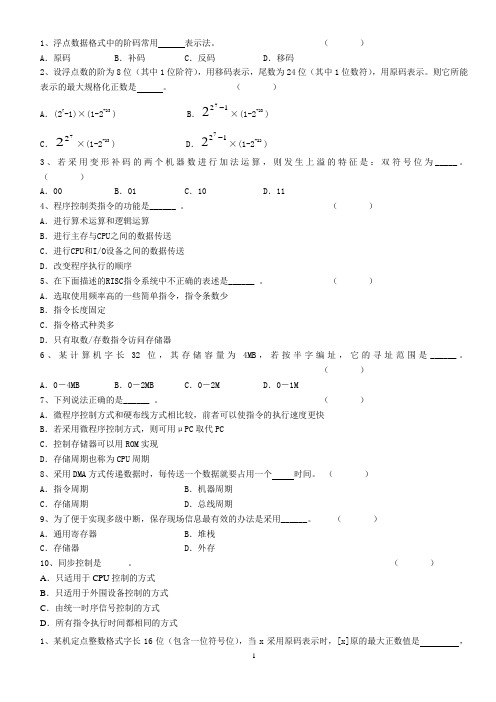
1、浮点数据格式中的阶码常用表示法。
()A.原码 B.补码 C.反码 D.移码2、设浮点数的阶为8位(其中1位阶符),用移码表示,尾数为24位(其中1位数符),用原码表示。
则它所能表示的最大规格化正数是。
()A.(27-1)×(1-2-23 ) B.1272-×(1-2-23 )C.722×(1-2-23 ) D.1272-×(1-2-22 )3、若采用变形补码的两个机器数进行加法运算,则发生上溢的特征是:双符号位为_____。
()A.00 B.01 C.10 D.114、程序控制类指令的功能是______ 。
()A.进行算术运算和逻辑运算B.进行主存与CPU之间的数据传送C.进行CPU和I/O设备之间的数据传送D.改变程序执行的顺序5、在下面描述的RISC指令系统中不正确的表述是______ 。
()A.选取使用频率高的一些简单指令,指令条数少B.指令长度固定C.指令格式种类多D.只有取数/存数指令访问存储器6、某计算机字长32位,其存储容量为4MB,若按半字编址,它的寻址范围是______。
()A.0-4MB B.0-2MB C.0-2M D.0-1M7、下列说法正确的是______ 。
()A.微程序控制方式和硬布线方式相比较,前者可以使指令的执行速度更快B.若采用微程序控制方式,则可用μPC取代PCC.控制存储器可以用ROM实现D.存储周期也称为CPU周期8、采用DMA方式传递数据时,每传送一个数据就要占用一个时间。
()A.指令周期 B.机器周期C.存储周期 D.总线周期9、为了便于实现多级中断,保存现场信息最有效的办法是采用______。
()A.通用寄存器 B.堆栈C.存储器 D.外存10、同步控制是______。
()A.只适用于CPU控制的方式B.只适用于外围设备控制的方式C.由统一时序信号控制的方式D.所有指令执行时间都相同的方式1、某机定点整数格式字长16位(包含一位符号位),当x采用原码表示时,[x]原的最大正数值是,最小负数值是;若采用补码表示,则[x]补的最大正数值是,最小负数值是。
计算机组成原理
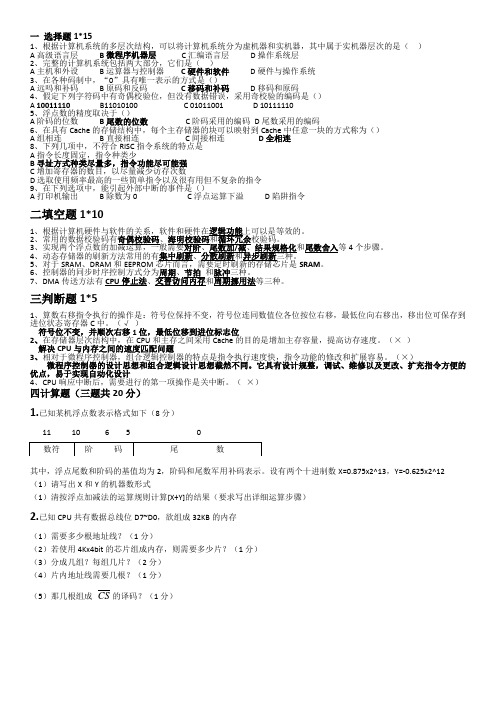
一选择题1*151、根据计算机系统的多层次结构,可以将计算机系统分为虚机器和实机器,其中属于实机器层次的是()A高级语言层B微程序机器层C汇编语言层D操作系统层2、完整的计算机系统包括两大部分,它们是()A主机和外设B运算器与控制器C硬件和软件D硬件与操作系统3、在各种码制中,“0”具有唯一表示的方式是()A远吗和补码B原码和反码C移码和补码D移码和原码4、假定下列字符码中有奇偶校验位,但没有数据错误,采用奇校验的编码是()A 10011110B11010100 C 01011001 D 101111105、浮点数的精度取决于()A阶码的位数B尾数的位数C阶码采用的编码D尾数采用的编码6、在具有Cache的存储结构中,每个主存储器的块可以映射到Cache中任意一块的方式称为()A组相连B直接相连C间接相连D全相连8、下列几项中,不符合RISC指令系统的特点是A指令长度固定,指令种类少B寻址方式种类尽量多,指令功能尽可能强C增加寄存器的数目,以尽量减少访存次数D选取使用频率最高的一些简单指令以及很有用但不复杂的指令9、在下列选项中,能引起外部中断的事件是()A打印机输出B除数为0 C浮点运算下溢D陷阱指令二填空题1*101、根据计算机硬件与软件的关系,软件和硬件在逻辑功能上可以是等效的。
2、常用的数据校验码有奇偶校验码、海明校验码和循环冗余校验码。
3、实现两个浮点数的加减运算,一般需要对阶、尾数加/减、结果规格化和尾数舍入等4个步骤。
4、动态存储器的刷新方法常用的有集中刷新、分散刷新和异步刷新三种。
5、对于SRAM、DRAM和EEPROM芯片而言,需要定时刷新的存储芯片是SRAM。
6、控制器的同步时序控制方式分为周期、节拍和脉冲三种。
7、DMA传送方法有CPU停止法、交替访问内存和周期挪用法等三种。
三判断题1*51、算数右移指令执行的操作是:符号位保持不变,符号位连同数值位各位按位右移,最低位向右移出,移出位可保存到进位状态寄存器C中。
计算机组成原理习题(附参考答案)
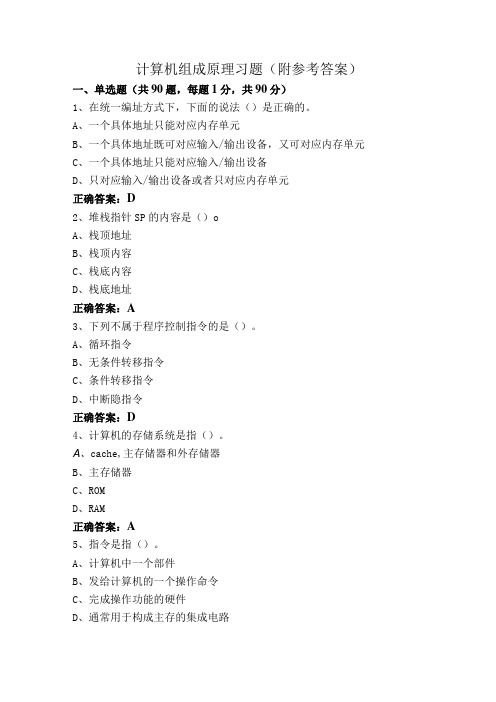
计算机组成原理习题(附参考答案)一、单选题(共90题,每题1分,共90分)1、在统一编址方式下,下面的说法()是正确的。
A、一个具体地址只能对应内存单元B、一个具体地址既可对应输入/输出设备,又可对应内存单元C、一个具体地址只能对应输入/输出设备D、只对应输入/输出设备或者只对应内存单元正确答案:D2、堆栈指针SP的内容是()oA、栈顶地址B、栈顶内容C、栈底内容D、栈底地址正确答案:A3、下列不属于程序控制指令的是()。
A、循环指令B、无条件转移指令C、条件转移指令D、中断隐指令正确答案:D4、计算机的存储系统是指()。
A、cache,主存储器和外存储器B、主存储器C、ROMD、RAM正确答案:A5、指令是指()。
A、计算机中一个部件B、发给计算机的一个操作命令C、完成操作功能的硬件D、通常用于构成主存的集成电路正确答案:B6、相对于微程序控制器,组合逻辑控制器的特点是()。
A、指令执行速度慢,指令功能的修改和扩展容易B、指令执行速度慢,指令功能的修改和扩展难C、指令执行速度快,指令功能的修改和扩展容易D、指令执行速度快,指令功能的修改和扩展难正确答案:D7、中断向量可提供()。
A、主程序的断点地址B、传送数据的起始地址C、被选中设备的地址D、中断服务程序入口地址正确答案:D8、迄今为止,计算机中的所有信息仍以二进制方式表示的理由是()oA、信息处理方便B、物理器件性能所致C、运算速度快D、节约元件正确答案:B9、相联存储器是按()进行寻址的存储器。
A、内容指定方式B、地址指定与堆栈存取方式结合C、堆栈存取方式D、地址指定方式正确答案:A10、若SRAM芯片的容量是2MX8位,则该芯片引脚中地址线和数据线的数目之和是()。
A、29B、21C、18D、不可估计正确答案:A11、若X=I03,尸-25,则下列表达式采用8位定点补码运算实现时,会发生溢出的是()oA^ x+yB、-x+yC> -χ-yD^ χ-y正确答案:D12、系统总线是指()oA、CPU、主存和外围设备之间的信息传送线B、运算器、寄存器和主存之间的信息传送线C、运算器、控制器和寄存器之间的信息传送D、运算器、寄存器和外围设备之间的信息传送线正确答案:A13、CPU可直接编程访问的存储器是()。
计算机组成原理计算题.doc
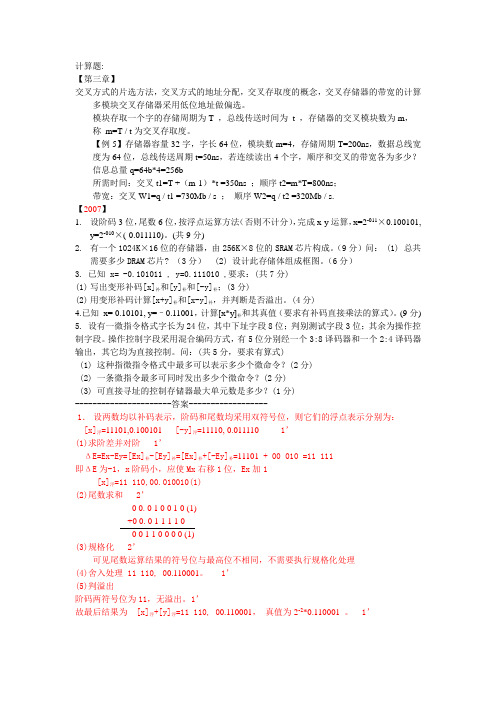
计算题:【第三章】交叉方式的片选方法,交叉方式的地址分配,交叉存取度的概念,交叉存储器的带宽的计算多模块交叉存储器采用低位地址做偏选。
模块存取一个字的存储周期为T ,总线传送时间为t ,存储器的交叉模块数为m,称m=T / t为交叉存取度。
【例5】存储器容量32字,字长64位,模块数m=4,存储周期T=200ns,数据总线宽度为64位,总线传送周期t=50ns,若连续读出4个字,顺序和交叉的带宽各为多少?信息总量q=64b*4=256b所需时间:交叉t1=T +(m-1)*t =350ns ;顺序t2=m*T=800ns;带宽:交叉W1=q / t1 =730Mb / s ;顺序W2=q / t2 =320Mb / s.【2007】1.设阶码3位,尾数6位,按浮点运算方法(否则不计分),完成x-y运算,x=2-011×0.100101,y=2-010×(-0.011110)。
(共9分)2.有一个1024K×16位的存储器,由256K×8位的SRAM芯片构成。
(9分)问: (1) 总共需要多少DRAM芯片? (3分) (2) 设计此存储体组成框图。
(6分)3. 已知 x= -0.101011 , y=0.111010 ,要求:(共7分)(1)写出变形补码[x]补和[y]补和[-y]补;(3分)(2)用变形补码计算[x+y]补和[x-y]补,并判断是否溢出。
(4分)4.已知x= 0.10101, y=–0.11001,计算[x*y]补和其真值(要求有补码直接乘法的算式)。
(9分)5. 设有一微指令格式字长为24位,其中下址字段8位;判别测试字段3位;其余为操作控制字段。
操作控制字段采用混合编码方式,有5位分别经一个3:8译码器和一个2:4译码器输出,其它均为直接控制。
问:(共5分,要求有算式)(1) 这种指微指令格式中最多可以表示多少个微命令?(2分)(2) 一条微指令最多可同时发出多少个微命令?(2分)(3) 可直接寻址的控制存储器最大单元数是多少?(1分)----------------------答案------------------1.设两数均以补码表示,阶码和尾数均采用双符号位,则它们的浮点表示分别为:[x]浮=11101,0.100101 [-y]浮=11110, 0.011110 1’(1)求阶差并对阶 1’ΔE=Ex-Ey=[Ex]补-[Ey]补=[Ex]补+[-Ey]补=11101 + 00 010 =11 111即ΔE为-1,x阶码小,应使Mx右移1位,Ex加1[x]浮=11 110,00.010010(1)(2)尾数求和 2’0 0. 0 1 0 0 1 0 (1)+0 0. 0 1 1 1 1 00 0 1 1 0 0 0 0 (1)(3)规格化 2’可见尾数运算结果的符号位与最高位不相同,不需要执行规格化处理(4)舍入处理 11 110, 00.110001。
计算机组成原理期末考试试题及答案(2)

计算机组成原理试题一、选择题(共20分,每题1分)1.零地址运算指令在指令格式中不给出操作数地址,它的操作数来自____C__。
A.立即数和栈顶;B.暂存器;C.栈顶和次栈顶;D.累加2.___C___可区分存储单元中存放的是指令还是数据。
A.存储器;B.运算器;C.控制器;D.用户。
3.所谓三总线结构的计算机是指_B_____。
A.地址线、数据线和控制线三组传输线。
B.I/O总线、主存总统和DMA总线三组传输线;C.I/O总线、主存总线和系统总线三组传输线;D.设备总线、主存总线和控制总线三组传输线.。
4.*计算机字长是32位,它的存储容量是256KB,按字编址,它的寻址*围是_____B_。
A.128K;B.64K;C.64KB;D.128KB。
5.主机与设备传送数据时,采用___A___,主机与设备是串行工作的。
A.程序查询方式;B.中断方式;C.DMA方式;D.通道。
6.在整数定点机中,下述第___B___种说法是正确的。
A.原码和反码不能表示 -1,补码可以表示 -1;B.三种机器数均可表示 -1;C.三种机器数均可表示 -1,且三种机器数的表示*围相同;D.三种机器数均不可表示 -1。
7.变址寻址方式中,操作数的有效地址是___C___。
A.基址寄存器内容加上形式地址(位移量);B.程序计数器内容加上形式地址;C.变址寄存器内容加上形式地址;D.以上都不对。
8.向量中断是___C___。
A.外设提出中断;B.由硬件形成中断服务程序入口地址;C.由硬件形成向量地址,再由向量地址找到中断服务程序入口地址D.以上都不对。
9.一个节拍信号的宽度是指_____C_。
A.指令周期;B.机器周期;C.时钟周期;D.存储周期。
10.将微程序存储在EPROM中的控制器是____A__控制器。
A.静态微程序;B.毫微程序;C.动态微程序;D.微程序。
11.隐指令是指___D___。
A.操作数隐含在操作码中的指令;B.在一个机器周期里完成全部操作的指令;C.指令系统中已有的指令;D.指令系统中没有的指令。
计算机组成原理设计题

计算机组成原理设计题计算机组成原理设计题是一种应用计算机组成原理知识进行系统设计和优化的问题,是计算机组成原理课程中的重要内容之一。
本文将围绕计算机组成原理设计题展开,介绍相关的参考内容。
1. CPU的设计在计算机系统中,CPU是核心部件,也是设计题中常见的重点。
参考内容包括:- 指令集体系架构(ISA)的选择,比如RISC、CISC等不同的体系结构,以及各自的优缺点;- 指令的编码和解码,包括指令长度、寻址方式等;- 控制信号的生成和传递,包括主存、寄存器和外设控制器的读写操作;- 数据通路的设计,包括寄存器、运算单元、多级缓存等。
2. 存储系统的设计存储系统是计算机中用来存储数据和指令的重要组成部分,也是设计题中的重点之一。
参考内容包括:- 主存储器的组织和管理,包括内存的划分、映射方式、数据的读写和访问过程等;- 高速缓存的设计和优化,包括缓存的大小、映射方式、替换算法等;- 虚拟存储器的设计,包括页面置换算法、页表的组织和管理等。
3. 输入输出系统的设计输入输出系统是计算机与外部设备进行交互的重要桥梁,也是设计题中需要考虑的部分。
参考内容包括:- 输入输出设备的接口标准和协议,如USB、PCI、SATA等;- I/O控制器的设计和实现,包括命令的解析和执行、缓冲区管理等;- 数据传输的优化,如DMA(直接内存访问)技术、中断控制等。
4. 性能优化和指标评估设计题中,性能优化和指标评估是重要的考察点。
参考内容包括:- 系统性能指标的定义和计算方法,如响应时间、吞吐量、利用率等;- 瓶颈分析和性能调优,包括利用硬件指令和并行计算等提升性能的方法;- 性能评估和测试,包括基准测试、压力测试、模拟器等工具的使用。
5. 其他设计题相关的知识除了上述内容,计算机组成原理设计题还可能涉及到其他相关的知识,如:- 操作系统的功能和原理,包括进程管理、内存管理、文件系统等;- 网络和通信原理,包括网络结构、协议、通信方式等;- 并行和分布式计算,包括多处理器系统、并行程序设计等。
- 1、下载文档前请自行甄别文档内容的完整性,平台不提供额外的编辑、内容补充、找答案等附加服务。
- 2、"仅部分预览"的文档,不可在线预览部分如存在完整性等问题,可反馈申请退款(可完整预览的文档不适用该条件!)。
- 3、如文档侵犯您的权益,请联系客服反馈,我们会尽快为您处理(人工客服工作时间:9:00-18:30)。
1.IEEE 754 format of X is (41360000)16, what is its decimal value?将十六进制数展开,可得二进制数格式为:0 100 0001 0 011 0110 0000 0000 0000 0000指数e=阶码-127=10000010-01111111= 00000011 =(3)10包括隐藏位1的尾数1.M = 1.011 0110 0000 0000 0000 0000 = 1.011011于是有:X = (-1)s * 1.M * 2e = +(1.011011)2 * 23 = + (1011.011)2= (11.375)102.Let the carry bits of an adder are C4, C3, C2, C1. C0 is the carry from the low bit. Please give the logic expressions of C4, C3, C2, C1 in ripple carry mode and carry look ahead mode respectively.(1)串行进位G1 = A1B1 , P1 = A1 ⊕ B1G2 = A2B2 , P2 = A2 ⊕ B2G3 = A3B3 , P3 = A3 ⊕ B3G4 = A4B4 , P4 = A4 ⊕ B4C1 = G1 + P1P0C2 = G2 + P2C1C3 = G3 + P3C2C4 = G4 + P4C3(2)并行进位C1 = G1 + P1C0C2 = G2 + P2G1 + P2P1C0C3 = G3 + P3G2 + P3P2G1 + P3P2P1C0G4 = G4 + P4G3 + P4G3G2 + P4P3P2G1 + P4P3P2P1C03.Suppose a computer with a clock frequency of 100 MHz as four types of instructions, and the frequency of usage and the CPI for each of them are given in table.(1)Find the MIPS of the computer and the T (CPU time) required to run a program of 107 instructions.(2) Combining comparing and branch instructions together so that compare instructions can be replaced and removed. Suppose each compare instruction was originally used with one branch instruction, and now each branch instruction is changed to a compare&branch instruction. Also suppose that the new proposal would decrease the clock frequency by 5%, because the new compare&branch instruction needs more time to execute. Find the new CPIave, MIPS, and T.CPIave = (0.4*2+0.*4+0.22*3)/0.92 = 2.9MIPS = f(MHz)/CPIave = (100*0.95)/2.9 = 32.76T = IC *CPIave/f(Hz) = (0.92*10000000)*2.9/(0.95*100*1000000)= 0.28s4 CPU has 16 address bus lines (A15-A0), 8 data bus lines (D7-D0), R/W (highlevel represents Read, while low level represents Write), MREQ control line for accessing memory (low level represents accessible).Memory space allocation: The minimal 8K are used for system program, which is composed of Read Only Memory chip; the following 24K are used for user program; the last 2K are used for system working.Now we have: EPROM 8K * 8 (contains CS control line only);SRAM 16K*1, 2K*8, 4K*8, 8K*8;Decoder 74LS138;and other logic gatesQuestions:(1) Select appropriate chips to form the required memory space. Which chipsare needed? How many chips are needed? Descript the corresponding data bus length, address bus length and control bus line.(2) Descript the address distribution of memory.(3) Descript select chip logic functions (片选逻辑函数) of each chip.(4) Descript the connection way among CPU, memory chips and 74LS138.解:(1)根据给定条件,选用EPROM:8K×8位芯片1片,其地址线13根,数据线8根,片选控制信号CS,无读写控制信号。
SRAM:8K×8位芯片3片,地址线13根,数据线8根,片选控制线号CS,读写控制线号R/W;2K×8位芯片1片,地址线11根,数据线8根,片选控制线号CS,读写控制线号R/W。
(2)A15 A14 A13 A12 A11 A10 A9 A8 A7 A6 A5 A4 A3 A2 A1 A0CS0 0 0 0 0 0 0 0 0 0 0 0 0 0 0 0 08K 0 0 0 1 1 1 1 1 1 1 1 1 1 1 1 1CS1 0 0 1 0 0 0 0 0 0 0 0 0 0 0 0 08K 0 0 1 1 1 1 1 1 1 1 1 1 1 1 1 1CS2 0 1 0 0 0 0 0 0 0 0 0 0 0 0 0 08K 0 1 0 1 1 1 1 1 1 1 1 1 1 1 1 1CS3 0 1 1 0 0 0 0 0 0 0 0 0 0 0 0 08K 0 1 1 1 1 1 1 1 1 1 1 1 1 1 1 1CS4 1 1 1 1 1 0 0 0 0 0 0 0 0 0 0 02K 1 1 1 1 1 1 1 1 1 1 1 1 1 1 1 1-(3) CS0 = (A15’*A14’*A13’)’ = Y0’CS1 = (A15’*A14’*A13)’ = Y1’CS2 = (A15’*A14*A13’)’ = Y2’CS3 = (A15’*A14*A13)’ = Y3’CS4 = (((A15*A14*A13)’)’*(A12*A11))’ =( (Y1’)’*A12*A11)’(4) 数据总线:由于选择的存储芯片数据总线与CPU数据总线都是8位,因此不需要进行扩展,一一对应D7~D0相联即可。
地址总线:系统程序区使用EPROM 8K容量,所以CPU的A12~A0链接到EPROM的片内地址总线A12~A0,CPU的A15~A13地址线经过74LS138译码,输出Y0连接到EPROM的片选;用户程序区使用3片SRAM 各8K容量,所以CPU的A12~A0链接到SRAM的片内地址总线A12~A0,CPU的A15~A13地址线经过74LS138译码,输出Y1、Y2、Y3分别连接到3片SRAM的片选。
系统工作区使用SRAM 2K容量,所以CPU的A10~A0链接到SRAM的片内地址总线A10~A0,CPU的A15~A13地址线经过74LS138译码,输出的Y7取反,与A12、A11相与,再取反连接到2K的SRAM片选。
5.CPU performs a program; it accesses cache 3800 and accesses main memory 200. Known that Tc = 50ns, Tm = 250ns. Solving that the efficiency (e) and Ta of the cache/memory system.命中率H = N e / (N C + N m)= 3800 / (3800 + 200) = 0.95主存慢于cache的倍率:r = t m / t c= 250ns / 50ns = 5访问效率:e = 1 / [r + (1 – r)H]= 1 / [5 + (1 – 5)×0.95] = 83.3%平均访问时间:t a = t c / e = 50ns / 0.833 = 60ns6.We use 16M*8bit memory chip to form a 64M*16bit main memory module.Required that the capacity of storage be expand, the access time be reduced.Questions:(1) How many 16M*8bit memory chips should be used?(2) Give the address length of each memory chip and address length ofmain memory module.(3) Descript select chip logic functions (片选逻辑函数) of each chip.Descript the connection way among encoder, CPU and memory chips.(4)For an address (2345678)16, give its body number and address inside the body.(1)8个(2)存储器芯片的地址长度为24位。
